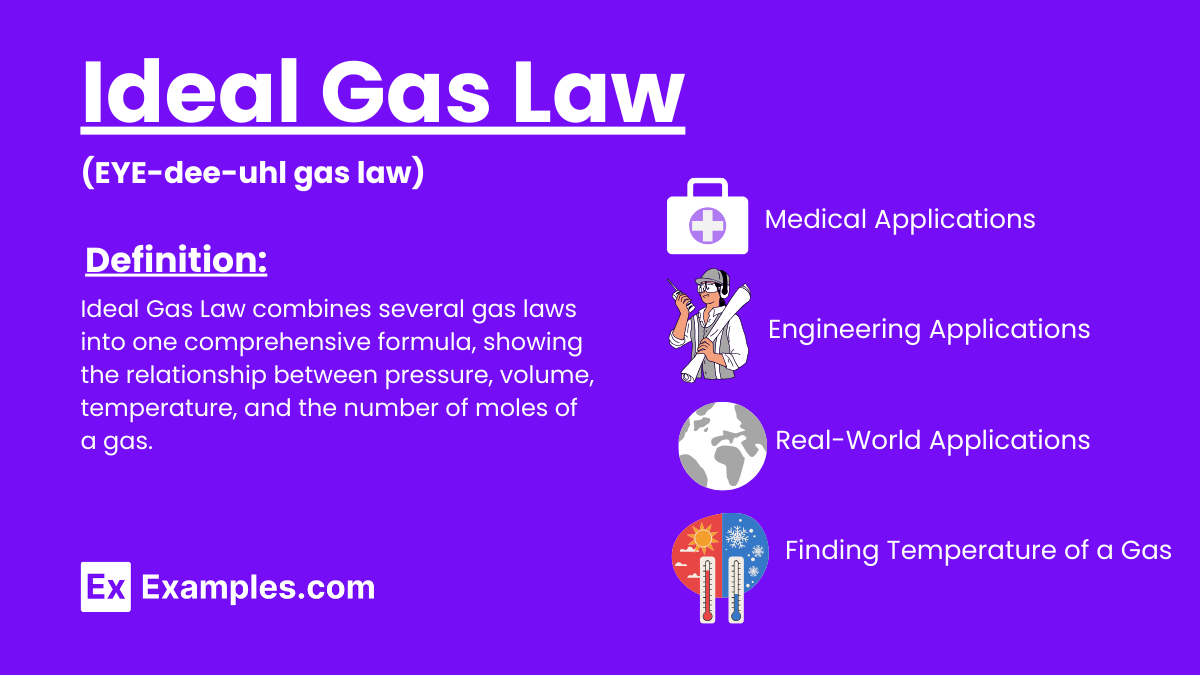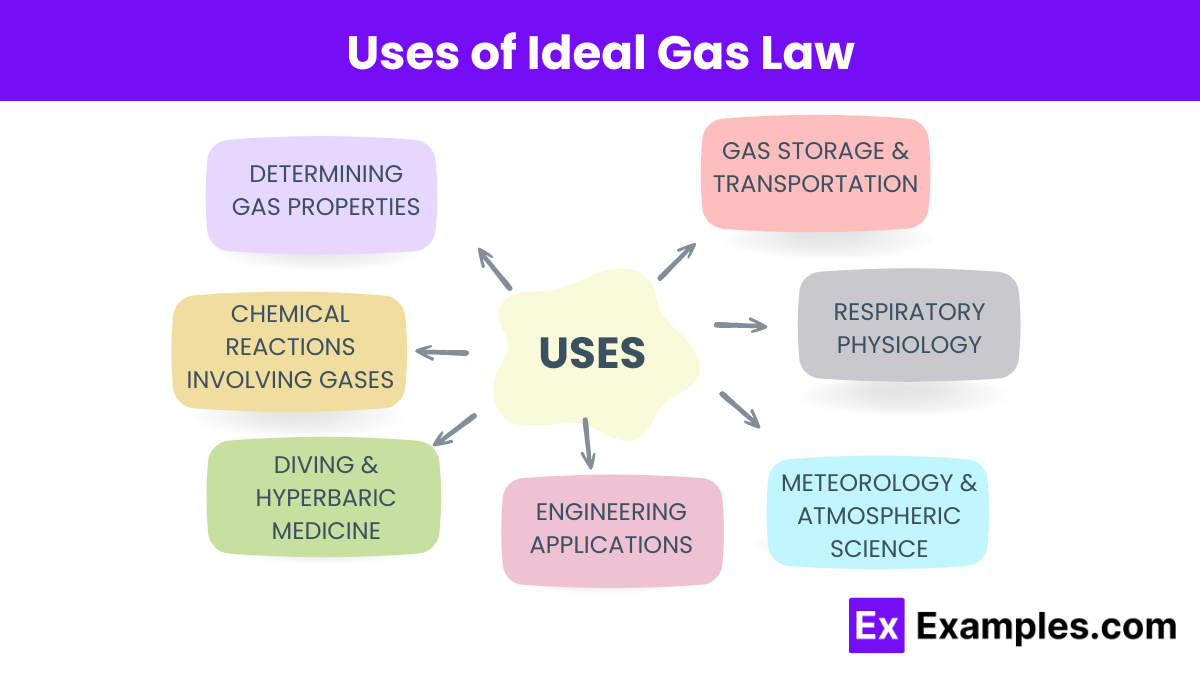What is the Ideal Gas Law equation?
PV = nRT
PV = nR/T
P/V = nRT
P = nRT/V


The Ideal Gas Law is a fundamental principle in physics that describes the behavior of ideal gases. It combines several individual gas laws into one comprehensive equation. This law is pivotal in understanding how gases respond to changes in pressure, volume, and temperature.
The formula for the Ideal Gas Law is:
Where:
| Quantity | Symbol | SI Unit | Common Unit(s) | Description |
|---|---|---|---|---|
| Pressure | 𝑃 | Pascal (Pa) | atm, mmHg, Torr | Force per unit area |
| Volume | 𝑉 | Cubic meter (m³) | Litre (L) | Space occupied by the gas |
| Number of Moles | 𝑛 | Mole (mol) | Amount of substance | |
| Ideal Gas Constant | R | Joules per mole per Kelvin (J/(mol·K)) | L·atm/(mol·K), cal/(mol·K) | Proportionality constant in the Ideal Gas Law |
| Temperature | T | Kelvin (K) | Celsius (°C) | Measure of the thermal energy |
The Ideal Gas Law is derived from combining several empirical gas laws: Boyle’s Law, Charles’s Law, and Avogadro’s Law. These laws describe the relationships between pressure, volume, temperature, and the number of moles of a gas. Here is a step-by-step derivation.
Boyle’s Law
Boyle’s Law states that the pressure of a gas is inversely proportional to its volume when the temperature and the number of moles are constant. 𝑃∝1/𝑉 or 𝑃𝑉=𝑘₁ where 𝑘₁ is a constant for a given amount of gas at a constant temperature.
Charles’s Law
Charles’s Law states that the volume of a gas is directly proportional to its temperature when the pressure and the number of moles are constant. 𝑉∝𝑇 or 𝑉/𝑇 = 𝑘₂ where 𝑘₂ is a constant for a given amount of gas at a constant pressure.
Avogadro’s Law
Avogadro’s Law states that the volume of a gas is directly proportional to the number of moles of gas when the pressure and temperature are constant. 𝑉∝𝑛 or 𝑉/n = 𝑘₃ where 𝑘₃ is a constant for a given pressure and temperature.
Combining the Laws
To derive the Ideal Gas Law, we combine Boyle’s, Charles’s, and Avogadro’s Laws. We know that: 𝑉∝𝑛𝑇/𝑃 This implies: 𝑉=𝑘₄𝑛𝑇/P where 𝑘₄ is a proportionality constant.
Rearranging the equation gives us: 𝑃𝑉=𝑘₄𝑛T
The constant 𝑘₄ is universal and is known as the ideal gas constant, R. Therefore, we write:
𝑃𝑉=𝑛𝑅𝑇
The relationship between pressure and temperature of a gas is described by Gay-Lussac’s Law. This law states that the pressure of a fixed amount of gas at constant volume is directly proportional to its absolute temperature.
Gay-Lussac’s Law indicates that when the volume and the number of moles of a gas are constant, the pressure of the gas increases with an increase in temperature and decreases with a decrease in temperature.
Gay-Lussac’s Law provides a clear and direct relationship between the pressure and temperature of a gas at constant volume. Understanding this relationship is crucial in various practical applications, such as cooking and the safe handling of pressurized containers.

Ideal gases follow the ideal gas law perfectly; real gases deviate due to intermolecular forces and finite molecular volume.
No, the ideal gas law predicts gas behavior accurately only under ideal conditions, usually high temperature and low pressure.
Assumptions include negligible molecular volume, no intermolecular forces, and perfectly elastic collisions.
The ideal gas law helps calculate the amounts of reactants and products in gaseous form, using volume and pressure relationships.
Avogadro’s Law states that equal volumes of gases, at the same temperature and pressure, have the same number of molecules, represented in the ideal gas law by n.
Temperature (T) must be in kelvins for accurate calculations since it directly affects gas volume and pressure.
The ideal gas law is applicable at high temperature and low pressure, where gases behave ideally.
P is pressure, V is volume, n is moles of gas, R is the gas constant, and T is temperature.
The gas constant R is 8.314 J/(mol·K).
Rearrange the ideal gas law to P = nRT/V and plug in the values for n, R, T, and V.
Text prompt
Add Tone
10 Examples of Public speaking
20 Examples of Gas lighting
What is the Ideal Gas Law equation?
PV = nRT
PV = nR/T
P/V = nRT
P = nRT/V
In the Ideal Gas Law, what does the constant R represent?
Volume
Pressure
Gas constant
Temperature
If pressure is measured in atmospheres, volume in liters, and temperature in Kelvin, what is the value of R?
8.314 J/(mol K)
0.0821 L atm/(mol K)
1.987 cal/(mol K)
0.8314 L atm/(mol K)
Which of the following represents the correct units for pressure in the Ideal Gas Law?
Kelvin
Liters
Atmospheres
Moles
How does the volume of a gas change if the temperature is increased while keeping pressure and moles constant?
Increases
Decreases
Remains constant
Doubles
If the number of moles of gas is doubled while keeping temperature and volume constant, what happens to the pressure?
Halves
Doubles
Remains the same
Quadruples
What happens to the pressure of a gas if its volume is halved while keeping temperature and moles constant?
Halves
Doubles
Remains the same
Triples
If the temperature of a gas is measured in Celsius, what must be done before using the Ideal Gas Law?
Convert to Kelvin
Convert to Fahrenheit
Convert to Rankine
Convert to Reaumur
What is the value of R when pressure is measured in Pascals, volume in cubic meters, and temperature in Kelvin?
8.314 J/(mol K)
0.0821 L atm/(mol K)
62.36 L torr/(mol K)
1.987 cal/(mol K)
Which variable is held constant in Charles's Law?
Pressure
Volume
Temperature
Moles
Before you leave, take our quick quiz to enhance your learning!

